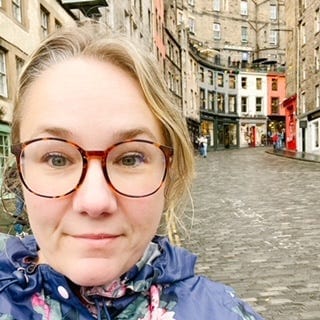My SD in Gov 2022 Themes and Takeaways
My head and heart are full after a whirlwind trip to the UK. I started off in London where I visited friends and family, worked for a day…

My head and heart are full after a whirlwind trip to the UK. I started off in London where I visited friends and family, worked for a day in the GDS offices with Keith, and attended the Converge Design Systems conference in Holborn.
Then I took the train to Edinburgh for Service Design in Government for three days packed full of wonderful people and talks and so much learning and many, many great conversations.
I’m a voracious notetaker, because focusing on summarizing things in my own words helps me understand and retain the content, and it keeps my mind from drifting off. But I rarely have time to revisit my notes so now I have a 35-page google doc that likely will sit there until something or someone spurs me to get rid of it (nb: I am happy to share a link to this if anyone wants the notes.)
But — one way for my note to live on is by summarizing my takeaways in public. So here we go. There were many, many lessons from this conference but these are the top things that have rattled in my head in the days after.
A side note, everyone comes to events like this with a unique perspective, looking for different things. These are just the things that stuck out to me personally, based on my own experiences and the challenges I am facing in my own work. For another perspective, Sam wrote a great summary of her experiences at the conference, and there’s plenty to explore on the #SDinGov hashtag on twitter.
1 — There’s value in what you have to say, and it’s better to share that imperfectly than not at all
I spoke at the conference, so probably my biggest takeaway is that I’m really glad I did the brave thing. My talk seemed to resonate with a lot of people; many approached me after and told me it was the highlight of the conference for them. I’m not a good public speaker, and my talk wasn’t a polished keynote: My voice wavered, my hands were shaking, I fidgeted with a hair band the entire time I spoke. And still, there was value in what I had to say, and it mattered to people that I said it.
2 —“Start with the people who are most at risk of being left behind.”
Shabira Papain gave an excellent keynote on inclusive design, and the quote above is from her talk. Soh-yon Park and Claudia Hopkins also ran an amazing session called Reforming design through equity seeking approaches. Both of these talks have had me thinking a lot about how I approach my work. Soh-yon did a great bit where she showed a critical email she received and pulled it apart for us to analyze, so we don’t make the same mistakes as her. It was so powerful to see an example in play.
Some things I want to take forward:
- Planning my design and research around the people with the most barriers, not the average user
- One codesign workshop isn’t enough. You need multiple touchpoints throughout, and before and after. The small things in between are what count the most.
- When you finish what you’re doing, show the results to the people involved. Don’t take it away and go silent. Show them the impact their contribution had.
3 — The importance of design systems and common components:
This one stuck out to me because it’s related to conversations I am having at work about reviving our design system.
Dean Vipond gave an excellent talk on the NHS design system, and in particular about having it in place really helped with their response to the pandemic. And Hilary Brownlie of Registers Scotland also talked about how gov.uk Notify helped them to communicate with Ukranian Refugees.
4 — Policy making is where the most important service design decisions are made.
This was a big theme I took away from the last SDinGov conference, so I was glad to dive in more. Liam Hawkes and Charlotte Moore from the Home Office talked about their experience working with policy teams, where they don’t understand how the things they do will play out in real life. Service Ownership is an approach to this (where teams own the whole service, not just parts of it)
To bring design to the policy world, we need to:
- be patient and helpful with policy teams, not isolate them with complicated language + ways of working
- help them understand the whole service
- embed design approaches in a way that will last long term.
5 — Treat your community like a service.
Imran gave an amazing lightning talk on building community, which was super relevant to me as I organize a community where I work. Although it was short, it was packed with so much great advice, like:
- Treating your community like a service means understanding the user needs, mapping out the user journey, and doing things like running retros.
- Communities are not self sustaining, and they are not meant to last forever.
- The best communities are the ones that are embedded into how the org works.
- There are no shortcuts to good relationships.
I also attended a workshop by Kara, Martin and Clara about building a design culture that delivers. They pointed out that when building design culture, you need many building blocks, with a range impact. Small interventions like stickers and meetups should be combined with large, impactful ones like service standards, guidance, regulations.
6 — There’s so much value in having lived experience on multi-disciplinary teams.
The big emotional point of the conference for me came when Usman (Ozzy) Anwar from the Ministry of Justice talked to Caroline Jarrett about his experience working in the prison leavers team. Ozzy himself had spent time in prison and talked how, although research is important, it’s only a start and is not nearly as impactful as having actual lived experience on your team.
This is something I keep thinking about — how we need to have more lived experience on services like this. But the bar to joining these teams is often too high. Is that something we can fix?
Other notable themes:
Don’t wait for people to complain about your service. This was a lightning talk by Catherine Reader that really stuck with me. When we are waiting for complaints, we are putting the responsibility on the users: “You have to tell us, it’s your job.” That’s really problematic. Because the problem becomes their problem, when really it’s something wrong with the service, it’s our problem.
Stop creating so many maps — they are not a good outcome of service design work! This session from Vicky Houghton-Price was one of my favourite sessions, it was so honest, practical and helpful. She argues that maps on their own are not solving the problem, yet we focus so much energy on them. Sometimes a sketch on paper is all the map you need to understand the problem. If you do need to do a map, approach with a Service Design lens — start with user needs, decide what its purpose is, keep it simple. Use it as a way to get to an outcome, not as the outcome itself.
Sometimes friction is good. Sometimes slowing things down, putting speedbumps in a user journey, leads to better outcomes. Millie, Georgia and Jess from Social Finance talked about their experience in matching homes for displaced Ukrainians, and how slowing down the process of matching refugees with home stays can mean that the refugees are more likely to end up in safe, engaged homes.
Figure out what can be automated, and what needs a human touch. You can’t do everything so find ways to automate the things that don’t need your direct attention. This came up in a number of talks but I first came across it in the talk “they are already in the air”
To use a service, people need compatibility, opportunity and motivation. This is called the COM-B model in behavioural insights. If users don’t have all three, they won’t use the service. So figure out which one(s) they don’t have, and work on unblocking that. This was a case study from Jude and Katie in their talk, “If you build it, they won’t come”
Future casting is a useful tool for anticipating results, in which you speculate on the future after your service, then test it out. Headlines from the future is a good example of this. A great talk from Bekki Leaver.
Moving on from the GDS revolution, the goal in digital gov now is centrally-backed reform to scale digital. We need a digital centre with strong communication, collaboration. A model like this is a weight off the shoulders of departmental digital leaders: a centre that says, what can we do to make this easier for you? This is from the day 3 Keynote by Paul Maltby. As someone who went from GDS to a government where there’s no digital centre, I think a lot about the role of GDS, so this was a helpful perspective.
A final thought
I loved this quote that Sophie finished the conference with:
“You write in order to change the world, knowing perfectly well that you probably can’t, but also knowing that literature is indispensable to the world… The world changes according to the way people see it, and if you alter, even but a millimeter the way people look at reality, then you can change it.”
James Baldwin. New York Times, 1979.


Comments ()